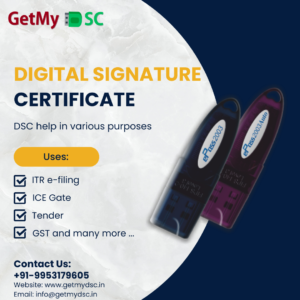In our increasingly digital age, where paperless transactions and electronic communication reign supreme, ensuring the authenticity and integrity of documents becomes paramount. Enter the digital signature certificate—a powerful tool that combines security, identity verification, and trust. Digital Signature Certificates (DSCs) are an essential part of digital transactions and communication in the modern era. They play a vital role in ensuring the authenticity, integrity, and security of digital documents and transactions. In this blog post, we will delve into how a Digital Signature Certificate work and understand its practical applications. Let’s break it down.
When it comes to web development, DSCs play a critical role in securing data transmitted over the internet. By using a DSC, web developers can ensure that the data they transmit is authentic, cannot be tampered with, and is only accessible by authorized parties. This is accomplished by encrypting the data using a unique digital signature that can only be decrypted by the intended recipient using their private key.
What is a Digital Signature Certificate?
Table of Contents

A Digital Signature Certificate is an electronic document that contains key information about the owner’s identity and is used to digitally sign electronic documents. It is a form of asymmetric cryptography, which means it uses a pair of keys – a private key and a public key – to sign and verify documents. The private key is known only to the owner and is used to sign documents, while the public key is made publicly available and is used to verify the signature.
A digital signature is a cryptographic mechanism that authenticates the identity of the signer and ensures that electronically transmitted documents remain unaltered. Think of it as the digital equivalent of your handwritten signature, but with superpowers. Here’s what makes it special:
- Identity Assurance: A digital signature binds the signer’s identity to the document. It’s like having a notary stamp, but in the digital realm.
- Document Integrity: When you sign a document digitally, it’s not just a scribble on a screen. The digital signature ensures that the document hasn’t been tampered with during transmission.
- Legally Binding: Digital signatures hold legal weight in many countries, including the United States. They’re more than just fancy pixels; they’re enforceable.
Digital Signature vs. Electronic Signature
Before we dive deeper, let’s clarify the distinction between digital signatures and electronic signatures:
- Electronic Signatures (E-Signatures): These encompass a broad range of solutions for accepting documents or transactions electronically. They’re convenient and widely used. However, not all electronic signatures are created equal. Some rely on basic authentication methods like email addresses or phone numbers.
- Digital Signatures: These are the Fort Knox of electronic signatures. They use Public Key Infrastructure (PKI) certificates from trusted Certificate Authorities (CAs). PKI involves two keys: a public key (shared with the world) and a private key (kept secret). Together, they create a key pair for encryption and decryption.
How does a Digital Signature Certificate work?

Step 1: Generating the Key Pair
The first step in obtaining a Digital Signature Certificate is to generate a key pair consisting of a private key and a public key. The private key is generated on the user’s device and is kept secure and confidential. The public key is generated from the private key and is made available for public use.
Step 2: Applying for a Digital Signature Certificate
The user then applies to a Certifying Authority (CA) for a Digital Signature Certificate. A CA is a trusted entity that issues Digital Signature Certificates after verifying the user’s identity. The user needs to submit their identity proof and other relevant documents as per the CA’s requirements.
Step 3: Verification by the Certifying Authority
The CA verifies the user’s identity by validating the submitted documents. This may involve physical verification, checking against government databases, and other means of authentication.
Step 4: Issuance of Digital Signature Certificate
Once the user’s identity is verified, the CA issues a Digital Signature Certificate. The certificate contains the user’s public key, their name, email address, and other relevant information, and is digitally signed by the CA using its private key. This creates a chain of trust, as the CA’s private key is used to sign the user’s certificate, and the CA’s certificate is signed by a higher-level CA, and so on, creating a hierarchical trust structure.
Step 5: Digital Signing
With the Digital Signature Certificate in hand, the user can now digitally sign electronic documents. To sign a document, the user uses their private key to create a unique digital fingerprint of the document, known as a hash. The hash is then encrypted using the private key, resulting in a digital signature. The digital signature is attached to the document, indicating that the document has been signed and verifying its authenticity and integrity.
Step 6: Verification of Digital Signature
To verify the digital signature, the recipient of the signed document uses the user’s public key, which is available in the Digital Signature Certificate, to decrypt the digital signature. This results in a hash, which is compared with a hash generated from the received document. If the two hashes match, it indicates that the document has not been tampered with and the digital signature is valid, thus verifying the authenticity and integrity of the document.
Practical Uses of Digital Signature Certificate
- Contracts and Agreements: Say goodbye to printing, signing, and scanning. Digital signatures streamline contract processes.
- Financial Transactions: Secure online banking, anyone? Digital signatures ensure the integrity of financial transactions.
- Government Services: E-filing taxes, applying for permits—DSCs make it all smoother.
- Software Distribution: Trustworthy software updates? DSCs vouch for them.
Conclusion on How Digital Signature Certificate Work
- Key Pair Generation: The signer gets their own digital identity by generating a key pair—a public key and a private key.
- Creating the Signature: When signing a document, the sender’s computer calculates a unique hash value of the file content. This hash value is then encrypted using the sender’s private key, creating the digital signature.
- Timestamp: To add an extra layer of trust, the signature includes a timestamp. It’s like noting the exact moment you sealed that envelope.
- Verification: When someone receives the digitally signed document, they use the sender’s public key to verify the signature. If the hash value matches, the document is legit.
In conclusion, a Digital Signature Certificate is a crucial tool for securing digital communication and transactions. It provides assurance about the authenticity, integrity, and security of electronic documents by leveraging asymmetric cryptography and a trusted chain of trust established by Certifying Authorities.
Digital signature certificates are the superheroes of the digital world. They protect us from document forgeries, ensure trust, and keep our virtual lives in order. So next time you sign electronically, remember the cryptographic magic happening behind the scenes.
Read More:
How to Choose the Right Type of Digital Signature Certificate?

